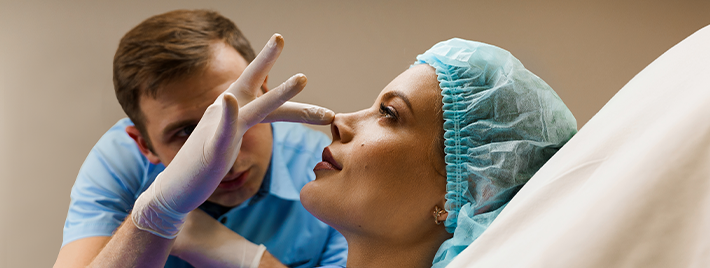Post Date: 1/7/2023

Rhinoplasty, also known as rhinoplasty or rhinoplasty, is a surgical procedure to change the shape or size of the nose.
It can be performed for a variety of reasons, including correcting birth defects or injuries that cause deformity in the nose, improving the appearance of the nose by changing its shape or size, correcting a deviated septum or nasal obstructions that cause difficulty breathing, and improving nasal function, correcting asymmetry in the nose.
Rhinoplasty operations can be performed on individuals of any age, but the best candidates are typical candidates older than 18 years of age with complete body development. It is important to have realistic expectations before undergoing the procedure and to be in good enough general health not to interfere with the operation.
There are two main techniques used in rhinoplasty: open rhinoplasty and closed rhinoplasty. In open rhinoplasty, the doctor makes an incision along the columella, the strip of skin that separates the nostrils. This allows the doctor to have greater visibility and access to the underlying nasal structures. In closed rhinoplasty, the doctor makes all incisions inside the nostrils, so there is no visible scarring.
Both techniques have their advantages and disadvantages, and the best approach will depend on the patient's specific goals and needs. Some common techniques that may be used during a rhinoplasty procedure include; removing excess bone or cartilage to reduce the size of the nose, reshaping the tip or bridge of the nose, changing the angle between the nose and upper lip, correcting a deviated septum or other functional problems in the nasal passages.
The specific techniques used will depend on the individual needs and goals of the patient as well as the doctor’s expertise and preferences.
Rhinoplasty is a surgical procedure that aims to change the shape or size of the nose, but may not be suitable for some individuals.
Since rhinoplasty is a surgical procedure, it may not be suitable for individuals with health problems of different nature. For example, a person with heart problems may not be considered suitable for rhinoplasty, because there is a possibility of heart rhythm disturbances due to the cardiovascular condition in the anesthetized patient.
Rhinoplasty is usually performed for individuals over the age of 18, as it requires fully developed nasal bones. Therefore, it may not be suitable for younger people whose nasal bones are not fully developed.
Rhinoplasty can be considered after pregnancy, but since there may be changes in hormone levels during this process, there is a possibility that the expected result may not be achieved.
The healing process after rhinoplasty may vary from person to person and usually takes several weeks. In this process, it is extremely important to follow the instructions given by the surgeon who operated in terms of the result of rhinoplasty surgery.
In the first week after the surgical operation, there is a bandage or nosepiece on the nose. This measure maintains the shape of the nasal area and also helps to reduce edema. Painkillers and other medications prescribed by the doctor are used to reduce edema and minimal pain that may occur.
In the second week after the procedure, the bandage and nosepiece are removed. A slight swelling may be observed on the nose. This complication usually resolves within a few days. Painkillers and other medications may not be needed in the following processes. By the third week, the nasal healing process is usually complete and the individual can return to normal activities.
Rhinoplasty, which is performed to change the shape and size of the nose, has many advantages. As a result of a successful rhinoplasty, the appearance of the individual's facial features improves and the general appearance becomes more aesthetic.
Rhinoplasty makes it possible to breathe better as a result of the improvement it provides in the nasal structure. By changing the shape of the nose, the self-confidence of the individual also increases. Since the rhinoplasty operation is performed under general anesthesia, the patient is not likely to feel pain.
If you consider having rhinoplasty surgery, contact us right away to get a free consultancy service from Prof. Dr. Selçuk İnanlı.